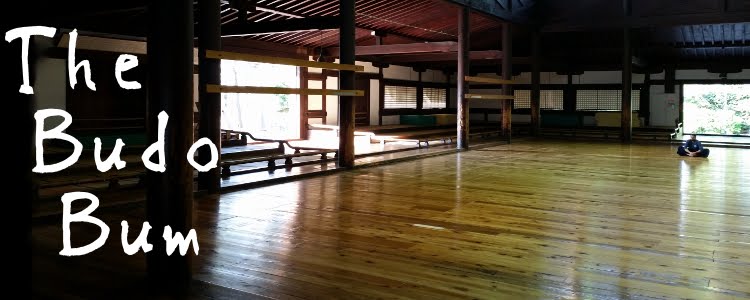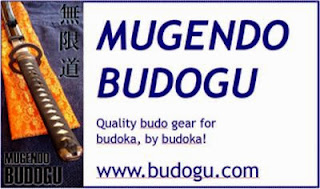Not the throws. Watch the ukemi!
I step wrong and my partner takes advantage, tips me slightly, steps across in front of me, dropping as she goes, finishes the pivot and draws me further forward, further off balance, and onto her hip, continues turning drawing me further off balance onto her hip, rising turning and I’m airborne, flying past her shoulder. Looking down I see the ceiling framed between my feet the instant before my back slams into the mat and I slap with my hand.
That’s a textbook ukemi. It’s what we think of when we talk about ukemi. There’s a world more to ukemi, receiving techniques, beyond taking safely taking spectacular falls from powerful fall. Big falls are the most visible and obvious form of ukemi, but they aren’t the only ukemi skills to found in budo practice.
In judo and aikido we tend to focus on the big falling techniques as ukemi, but anything where you are receiving an attack is a form of ukemi. “Ukemi” is 受身 which is literally “receiving body.” When we approach ukemi as how we receive whatever happens, there are a lot more skills that are clearly ukemi.
In budo, the obvious thought for ukemi is how to receive attacks. For judoka like me, one of those is how to receive being strangled. I happen to like attacking shime waza (chokes and strangles) in newaza, so often I find myself teaching people how to handle, how to receive these attacks. The ukemi for shime waza starts with dropping your chin to try and get it in the way of the attack. After that there are tricks for dealing with particular types of attacks that can allow you receive the attack and neutralize it. These are all forms of ukemi.
The obvious form of ukemi are the blocks that karateka learn for receiving attacks, punches and kicks. Blocks are the most basic way of receiving a strike, but everything that has strikes and thrusts has ways of dealing with them. Think about how your art deals with striking attacks. Those techniques are ukemi. In the Nage No Kata of judo the first response to an overhand strike is to blend and throw the attacker with seoi nage. Karateka learn sophisticated blends and redirections. With swords there are kiri otoshi and suriage techniques.
In Shinto Muso Ryu there are many techniques for receiving sword attacks by the jo side. There is also the skill of receiving jo thrusts when you are on the tachi side of training. There numerous places in the kata where tachi has to receive a thrust. Taking a stick to the solar plexus is hardly what I would call the highlight of training, but learning to receive these shots properly is important. That’s ukemi.
The ukemi that may be the most interesting is the ukemi for dealing with joint locks. Raw muscular resistance is not recommended. Oddly enough, the trick is to relax into the attack. The joint can move and stretch better if you’re relaxed. The muscles that can provide physical resistance to the attack work better from a relaxed base, and are stronger when their opposites aren’t firing as well. This ukemi may be harder to learn than the classic breakfall ukemi. Like breakfall ukemi you have to learn to stay relaxed when things go wrong and something is happening that would normally be unpleasant. With breakfall ukemi the unpleasantness lasts a moment. Joint lock ukemi doesn’t end quickly. In judo randori, people hate to surrender too easily, so they will resist as long as they safely can (and some stubborn fools resist longer than that). It takes patience and real effort to learn good ukemi for joint locks.
There is a lot to be learned under the heading of ukemi. You have to learn discretion about what can be successfully resisted, and what should be accepted and submitted to before you get hurt. That discretion is a big thing. I tell students that unless they are going for an Olympic medal, resisting an armbar probably isn’t worth the health of their elbow. That goes for other techniques as well. The safest course is almost always to go with a technique and take a fall rather than resisting. It takes a lot of practice, and more than few bumps, bangs and bruises to learn to discern when a technique can be resisted and when it shouldn’t be.
In any art, but particularly in judo, our ego will tell us that our partner shouldn’t be able to throw us. She’s too small. He’s not good enough. She’s not fast enough. He’s not strong enough. My ego can come up with a million reasons why I shouldn’t accept the technique and take the fall, reasons why I should use what I know about receiving the technique to jam it and block it. Learning to ignore our ego is another part ukemi. Learn to do what is healthy and good, rather than what makes our ego feel good and getting injured because of it.
Over my years of practice, I’ve found good ukemi skills to be the most useful things I’ve learned in the dojo. Tripping, falling off my bike, slipping on the ice, these are all places that use the big ukemi skills.
As your ukemi skills increase, so do your range of options. Judoka are notorious for reversing attacks. Until your skill at just accepting the attack and absorbing the energy becomes fairly sophisticated reversals are difficult. As you develop and feel for more and more subtle movement and the direction of the energy coming at you, it becomes easier and easier to take an attack, flow around the energy and turn it into a counter. Yoko guruma is wonderful for this. Flow around your attackers energy and the thrower becomes the thrown.
If you resist so hard that your opponent can’t even begin an attack, you’ll never get the counter. Or worse, your partner will find a way around your strength and throw you anyway. Ukemi is one of the best ways of learning to do that most common of all martial arts corrections, relax.
Ukemi skills don’t work when you’re stiff. Taking a fall when you are scared and tense hurts. We all do it as beginners, and I remember that discomfort. Learning to breath and relax whatever happens takes time and experience. It’s as useful a lesson outside the dojo as it is on the mat. Life is full of surprises, pleasant and otherwise, but breathing and relaxing will get you through most of them pretty well. Not just slipping on the ice, but slipping verbally, or dealing with that rude, pushy guy in the office. Just breathing and relaxing, instead of tensing up and diving straight into the oncoming energy, often will let you take control of a difficult situation and turn it around.
That’s a fundamental aspect of ukemi, of the skill of receiving any attack. Don’t tense up. Stay relaxed. Things hurt more when you’re tense. You just can’t move or think as well when you’re tensed up. Learning to relax and flow with the energy coming at you can make all the difference, on the mat or off. We tend to get tense and stiff when we’re feeling defensive, and that drives an entire set of reactions that an opponent can manipulate. In randori, if you’re defensive you become overcommitted in certain directions and you can’t respond well to attacks that don’t come from the direction you’re committed to.
Relax, and you become more stable and more flexible. You can relax and absorb the attacks from the side as well as the one barrelling in from head on. If you’re all stiff, you can only resist in one direction. Just because you are all set to resist in one direct does not put your opponent under any obligation to attack from that direction. Relax so you can flow with whatever comes your way. If you need to negate that attack, you can do that better when you’re relaxed. If you need to counter, you’d better be relaxed for that too. And if the best thing is to accept the attack, go with it, take the big ukemi and protect yourself that way, you want to be relaxed for that too.
Notice I didn’t say what kind of attack. It’s doesn’t matter if the attack is physical or verbal. If all your energy is focused in one direction, you’re going to get taken down by anything coming from another direction. Learning to receive is a critical skill.
As a massage therapist once told my friend Wendy "You can recognize martial artists the moment you lay your hands on them. They always relax to pain."
Relax. Do your ukemi.









